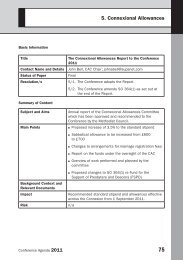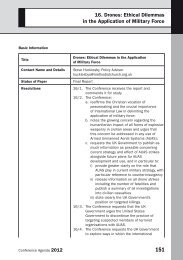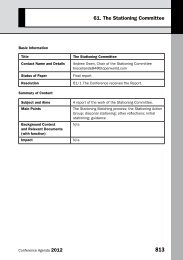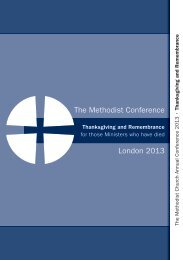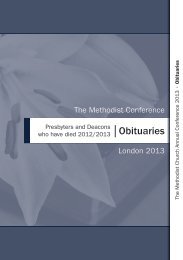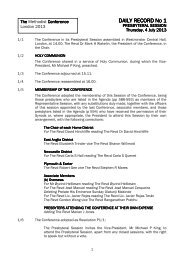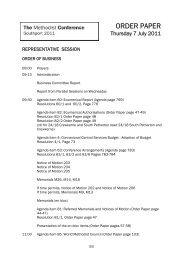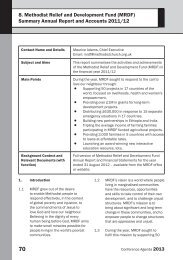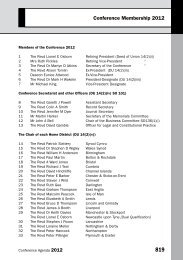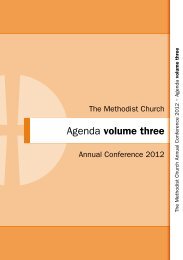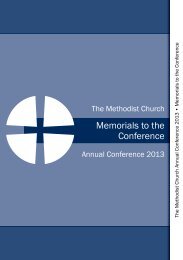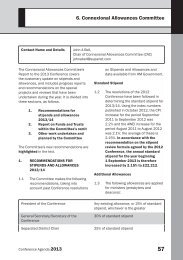Agenda Volume 2 - Methodist Conference
Agenda Volume 2 - Methodist Conference
Agenda Volume 2 - Methodist Conference
You also want an ePaper? Increase the reach of your titles
YUMPU automatically turns print PDFs into web optimized ePapers that Google loves.
41. The Discipleship and Ministries Learning Network<br />
work being done to cement the<br />
central place of Scholarship,<br />
Research and Innovation within the<br />
DMLN and the Church more broadly.<br />
Context:<br />
5.1 In many ways, NoM 102 reinforced<br />
what was contained within the<br />
Fruitful Field report, which identified<br />
scholarship, research and innovation<br />
(SRI) as a core purpose of the DMLN,<br />
including staff time across the<br />
Connexion, and a senior coordinating<br />
post within DMLN to direct SRI. The<br />
Fruitful Field report contains within<br />
it sufficient commitment to this area<br />
of the Church’s life that, as the DMLN<br />
begins to come into formal existence<br />
and as appointments are made, a<br />
clear and direct response to the NoM<br />
will be lived out naturally.<br />
5.2 Alongside this general affirmation,<br />
the <strong>Conference</strong> provided a clear<br />
indication of how and why it believed<br />
scholarship and research should<br />
be sponsored by the <strong>Methodist</strong><br />
Church. The <strong>Conference</strong> affirmed<br />
that whilst it believed scholarship<br />
and research should be supported<br />
by the Church in partnership with<br />
universities it should only do so<br />
where the scholarship and research<br />
activities fulfilled the purposes of<br />
the Fruitful Field Report and was<br />
considered a good use of resources.<br />
The purposes set out in the Fruitful<br />
Field Report allow for criteria to be<br />
established about which types of<br />
SRI activity the Church can support<br />
directly whilst responsible good<br />
steward of its precious resources.<br />
5.3 This approach, directed by the 2012<br />
<strong>Conference</strong>, rightly indicated that<br />
it would be unwise simply to begin<br />
conversations with universities,<br />
or indeed to develop existing<br />
conversations, without establishing<br />
first a clear idea of why we are<br />
doing so and what we hope to gain<br />
from these conversations across<br />
the whole of the Church. Although<br />
recognizing that in some contexts<br />
there will be time-sensitive decisions<br />
to be made, this approach requires<br />
that the development of partnerships<br />
with Higher Education Institutions<br />
(HEIs) becomes an ongoing process<br />
over the coming months and years,<br />
and throughout the lifetime of the<br />
DMLN, as the needs and priorities of<br />
the <strong>Methodist</strong> Church develop. We<br />
must therefore prioritise the careful<br />
discernment of the church’s needs<br />
over quick decision making in local<br />
contexts to protect relationships<br />
which may ultimately not serve those<br />
needs in the best ways. The Church<br />
must maintain a clear understanding<br />
of why it wishes to sponsor SRI<br />
activity, how it will do that, how<br />
much resource it can commit to it,<br />
and what it hopes to achieve from<br />
it. From that point, it must sustain<br />
an open and enquiring approach to<br />
developing relationships wherever<br />
they can form in a manner which<br />
is most beneficial to achieving the<br />
Church’s purposes.<br />
5.4 Although the process for responding<br />
to NoM 102 may leave an unclear<br />
picture about specific institutional<br />
partnerships, the resolutions of<br />
464<br />
<strong>Conference</strong> <strong>Agenda</strong> 2013



